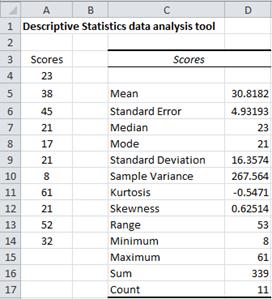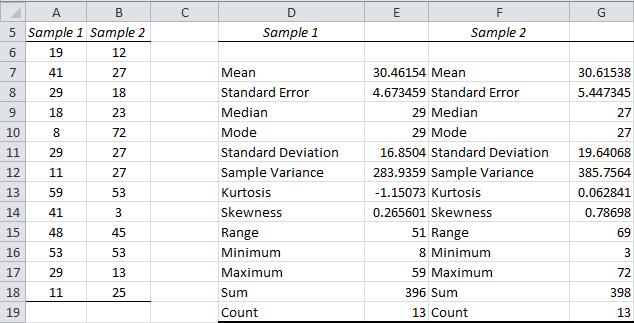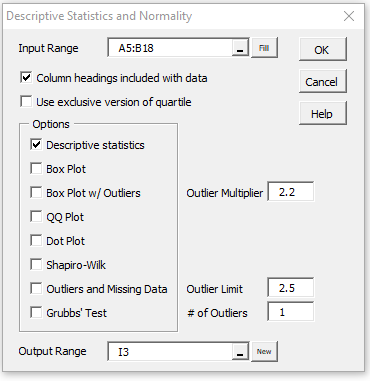On this webpage, we describe two data analysis tools that generate several key descriptive statistics for a data set.
Excel Support
Excel Data Analysis Tool: Excel provides a data analysis tool called Descriptive Statistics which produces a summary of the key statistics for a data set.
Example 1: Produce a table of the most common descriptive statistics for the scores in column A of Figure 1.
Figure 1 – Output from Descriptive Statistics data analysis tool
The output from the data analysis tool is shown on the right side of Figure 1. To use the tool, select Data > Analysis|Data Analysis and choose the Descriptive Statistics option. A dialog box appears as in Figure 2.
Figure 2 – Dialog box for Excel’s data analysis tool
Now click on Input Range and highlight the scores in column A (i.e. range A3:A14). If you include the heading, as is done here, check Labels in first row. Since we want the output to start in cell C3, click the Output Range radio button and insert C3 (or click on cell C3). Finally, click on the Summary statistics checkbox and press the OK button.
Note that had we checked the Kth Largest checkbox, the output would also contain the value for LARGE(A4:A14, k) where k is the number we insert in the box to the right of the label Kth Largest. Similarly, checking the Kth Smallest checkbox outputs SMALL(A4:A14, k). The option Confidence Interval for Mean option generates a confidence interval using the t distribution as explained in One Sample t Test.
Multiple Sample Example
Excel’s Descriptive Statistics data analysis tool also allows you to report on multiple sets of data at the same time, as shown in the following example.
Example 2 – Use Excel’s Descriptive Statistics data analysis tool to show the descriptive statistics for the two samples on the left side of Figure 3.
The output from Excel’s Descriptive Statistics data analysis tool is shown on the right side of Figure 3.
Figure 3 – Excel’s Descriptive Statistics data analysis
Real Statistics Support
Real Statistics Data Analysis Tool: The Real Statistics Resource Pack provides the Descriptive Statistics and Normality data analysis tool which outputs the above statistics plus GEOMEAN, HARMEAN, MAD, AAD, and IQR. But instead of just generating the numerical value of each statistic, as Excel’s Descriptive Statistics data analysis tool does, the Real Statistics data analysis tool outputs the appropriate Excel formula for computing each statistic (see Figure 4 below). Thus whenever the input data values change, the output values will change automatically as well.
The Real Statistics Descriptive Statistics and Normality data analysis tool allows you to report on multiple sets of data at the same time, as shown in the following example.
Real Statistics Example
Example 3 – Use Real Statistics’ Descriptive Statistics and Normality data analysis tool to show the descriptive statistics for the two samples on the left side of Figure 3.
Press Ctrl-m and select the Descriptive Statistics and Normality option. A dialog box will now appear as shown in Figure 4. Insert A5:B18 into the Input Range, making sure the Column headings included with data option is checked, and select the Descriptive Statistics option.
Figure 4 – Real Statistics dialog box
After clicking the OK button, the output shown in Figure 5 is displayed.
Figure 5 – Descriptive Statistics data analysis
As stated above, the data analysis tool generates formulas in each cell instead of the numerical values. E.g. cell J6 contains the formula =AVERAGE(A6:A18) instead of the value 30.46154.
Also note that cell J23 contains the formula =IQR(A6:A18), i.e. IQR based on the inclusive version of the quartile function. If you check the Use exclusive version of quartile field in the dialog box shown in Figure 4, then cell J23 would contain the formula =IQR(A6:A18, TRUE), i.e. IQR based on the exclusive QUARTILE.EXC function, producing the values 30 and 33.5 in cells J23 and K23 of Figure 5.
Examples Workbook
Click here to download the Excel workbook with the examples described on this webpage.
Reference
ExcelTip (2021) How to perform descriptive analysis in Excel
https://www.exceltip.com/tips/descriptive-statistics.html





I love this! Having just come from the world of pharmaceutical research this explanation makes me so excited!
This is very complicated for a person who has not done this in a very long time. I am more lost and confused than i was before reading this. This complicates things and makes me want to drop this class.
Hello Angel,
I agreed that this is not so easy. This webpage only describes the data analysis tool. It might be better to first read the part of the website at https://real-statistics.com/descriptive-statistics/
Charles
I agree with you. so lost
Too many steps that are difficult to understand for someone who does not use this type of tools or formats on a daily basis. Is there another way to simplify this? TOO MANY STEPS NOT ENOUGHT VISUALS. not very good teaching tool. |:(
I appreciate your comment even though it is not favorable to me. In any case, I will continue to try to make the material more understand to a larger audience. I know in advance that not everyone will understand the materials and tools. I also understand that if I simplfy things too much some part of the audience will become bored and stop using the website and tools. This is always a compromise. So far I have managed to attract a large audience and many people are using the website and software for their work and studies.
Charles
exactly. I want to cry.
I do not understand any of this
Michelle,
This webpage describes two data analysis tools. The first is supplied by Excel. The second is supplied by the Real Statistics add-in to Excel. You can access this data analysis tool (and others) once you have downloaded and installed the free Real Statistics add-in.
Charles
same
How do you determine regression equations? How to break it down step by step?
Hi Sheryl,
See
https://www.real-statistics.com/regression/
https://www.real-statistics.com/multiple-regression/
Charles
hi
whenever i am doing output range its showing me, ‘Compile error in hidden module: Analysis’. please help
Hello Rajesh,
What do you see when you enter the formula =VER() in any cell?
If you send me an Excel file with your data, I will try to figure out what is going wrong.
Charles
I am using this tool at the moment to analyse a set of data from 10 M&As but the problem is, it is hard for me to explain/interpret the results in my analysis.
In what way is it hard for your to explain/interpret the results?
Charles
Question regarding the MAD:
MAD can be Mean Absolute Deviation or Median Absolute Deviation? With the sample data set this function returns 12. Using =SUM(ABS(K2:K14-AVERAGE(K2:K14)))/COUNT(K2:K14) Excel returns 13.7988165680473 and using =SUM(ABS(K2:K14-MEDIAN(K2:K14)))/COUNT(K2:K14) it returns 13.4615384615385 (both array entered.)
Obviously I am not following something, but what?
Very good teaching but i have not exactly understood statistical tools used to analyse both quantitative and qualitative data